Jakub Bargielowski D.F.C. Fighter Pilot 315 Squadron (Polish)

Jakub Bargielowski D.F.C.
Sadly, Jacub passed away on the 22nd February 2010
Jakub Bargielowski is known as either Kuba (the diminutive form of the name) to his Polish friends and relatives or as John by his friends in Australia.
Kuba was born on the 25th of July 1921 in a place called Garbow near Lublin. Garbow is situated about 20 kilometres from Lublin on the main highway from Lublin to Warsaw.
Kuba attended the local school, which consisted of only one room. Four years later his father sent him to a cousin in Deblin, where he continued his education to the completion of Primary school. Deblin was a base for the Polish Air Force Officer’s Training School. He often saw aircraft flying about and took great interest in them.
In the spring of 1937, Kuba applied to the Air Force Cadet School in Bydgoszcz. He was eventually called to Warsaw, to the Central Medical Establishment and then to Bydgoszcz for the entry examination, which he passed. Later he was selected for the NCO pilot’s course. At the end of spring, 1938 he went with the first squadron on the gliding course to Ustianova. Flying was carried out on a glider of very simple construction called the “Crow”. At the end of the course in Ustianova the course returned to Swiecie, from where they were posted to a place called Sobiejuchy near Znin. There they started their training on single engined aircraft, the R.W.D. 8.
Kuba tells the story of when he went home on his first leave. His dear Mum found out he was training to be a pilot and gave him some sound advice. “Remember son, always fly slow and low and nothing will happen to you.” Not knowing anything about flying, she was certain that her advice was the best in the world. Taken as a cadet in 1938
Taken as a cadet in 1938
In Autumn 1938 he moved to flying aerobatic aircraft at Krosno. In late Spring 1939 he was posted to Ulez on the six week advanced pilot’s course. At the end of the Ulez course there was the opportunity to go to Deblin to do the fighter pilot’s course. The base commander asked who wished to become a fighter pilot and who wanted to be on bombers. Those who wanted to be in fighters were split in to pairs and required to undertake a flying test, performing a series of manoeuvres whilst being observed from the ground. The second part of the contest was to shoot down, with a camera gun, paper parachutes, which were thrown at varying heights. The trainee was required to attack it from different angles. With the results analysed, Kuba was found t be the best of the trainees and was assured of place in the fighter pilot’s course.
Kuba was there as war erupted and on the 6th of September the Germans bombed the airfield. On the 8th, the Cadets were formed up for a long march and went south-east towards a rendezvous with transport that would take them into Romania. After the first day, the main roads were so choked with refugee traffic they moved to smaller roads and travelled at night. They made good progress until they reached a Polish strong point at Wlodzimeirz Wolynski, Officer Cadet School of Artillery where their infantry training was put to use. The School was being attacked by the Germans. The cadets witnessed one of the last cavalry charges of the war where the Polish Cavalry destroy German infantry which had been deprived of armour support. Prior to the assault being renewed, the cadets were ordered out of the area.
A couple of days later on the 18th of September, the group were near Dubno and noted armoured cars and heavy lorries which had red stars painted on them. Captured!! All the boys were unhappy about it as they felt that the Russians had betrayed them. Held in the Polish Army barracks there, their number swelled every day as more Polish servicemen were captured. All the officers were separated and taken away. On the 26th of September, the soldiers and airmen in the barracks were loaded into cattle wagons and transported into modern day Bellarus. It was here that he unsuccessfully tried to escape.
On the 1st of October he was at a transit point in Novograd and on the 20th, Kuba was one of about a thousand people moved to the Black Sea where they spent the winter at hard labour in a quarry. Kuba made pans to escape when the weather warmed up in May 1940 they were again loaded into cattle trucks and taken to another quarry the far North. After refusing to sign documents in Russian and English that stated that because the men were there voluntarily, they did not want the Americans to pay the Russians upkeep of one dollar per man per day. The Russians were very angry and the NKVD came in to begin interrogation. On the 22nd of May 1940, Kuba and his group of about three hundred prisoners were taken from their usual quarry to another, where they were formed into four lines told to raise their arms and forced to kneel on the ice.
A little distance from the men were some tarpaulins. When they were lifted they saw a number of machine-guns with soldiers manning them, ready to fire. They waited on the ice, kneeling with their arms raised, waiting to die. When some people could no longer hold their hand up or kneel without swaying , they were encouraged with the aid of a bayonet to correct their position.
Above them, on the top of the fifty-metre escarpment stood an officer and next to him was a soldier carrying a portable radio with a battery the size fitted to a car. During the night, there was a heavy snowfall. The men sensed the Russians were having troubles with their communications system and were awaiting further orders. they were on the ice from 7pm till about 5am the following morning. Everyone was praying but Kuba did not believe that this was the end. He believed that they only wanted to scare the men because we did not work hard enough.
The shift they were supposed to relieve was still working and one of the workers left his place of work to relieve himself and saw them all kneeling on the ice as by now there was enough light to see. He returned to his workmates and told them what he had seen. The entire shift picked up their tools, ran to high ground and began to shout and wave their tools in a threatening manner. The NKVD Officer in charge realising that what was planned for us would not remain secret, gave the order for the men to return to the camp.
On returning to the camp, they were given a small piece of bread. Then they were ordered to assemble, with all their belongings for another inspection and search. Kuba had a small pocket knife which he hid in his piece of bread and did not lose it.
The Russians then led them to the railway station where they were loaded into cattle trucks. In the middle of the floor of each truck was a pipe with a metal funnel, the Russian version of a luxury toilet. Each truck carried about forty people. There was just enough room to breathe. They travelled for a week in these conditions to a camp even further north, called Kotlas. Three or four days later as part of a column one thousand strong Kuba was marched out to a place called 24 Lagpunkt-Chobju Uchta, near the River Pieczara, where the men would have to cut down trees and build themselves a camp. Oil had been discovered there, which was the reason for the activity.
At this point Kuba became very sick with a blindness and he was moved to Camp 13 (Termination). The blindness developed in paralysis and muscular spasm. Kuba was waiting to die. After some time one of the other prisoners brought in some pine branches, stripped the needles off and boiled them up in a billy can. Reluctantly he drank the vile concoction and began to recover and soon was able to get up and walk around.
On the 8th of October 1940, the men were moved to 9 Lagpunkt near a place called Chyria Woryk, where they worked a sawmill, cut down trees and built a railway line. It was here that Kuba experienced the lowest temperature of his entire life. It was –64C.
In June 1941 he was transferred back south. At this time the British plan to get the Polish Armed Forces out of Russian was beginning to take effect. As pilots were in great need in England, they were separated out and one hundred and sixty-four of them were railed to Arkangelsk before being put on a returning steamer and sent to England. When the y made it to the ship in late August, they were all overjoyed to have been released from Russian slavery.
Kuba reached England in mid-October 1941. They were sent to Hucknall for quarantine and medical check-ups. ON the 21st of February 1942, Kuba was posted to St. Andrews for the basic airman’s course, which he competed in June. From there he was posted to back to Hucknall to do basic flying training again and from there he was transferred to 25 (P) EFTS at Newton. ON the 17th of January 1943, Kuba was awarded his pilot’s wings and was promoted to Sergeant.
From there he went to 41 OTU at Hawarden near Chester towing targets and from there to 61 OTU at Rednal at the end of August. He was at Rednal doing air gunnery until the 28th of December.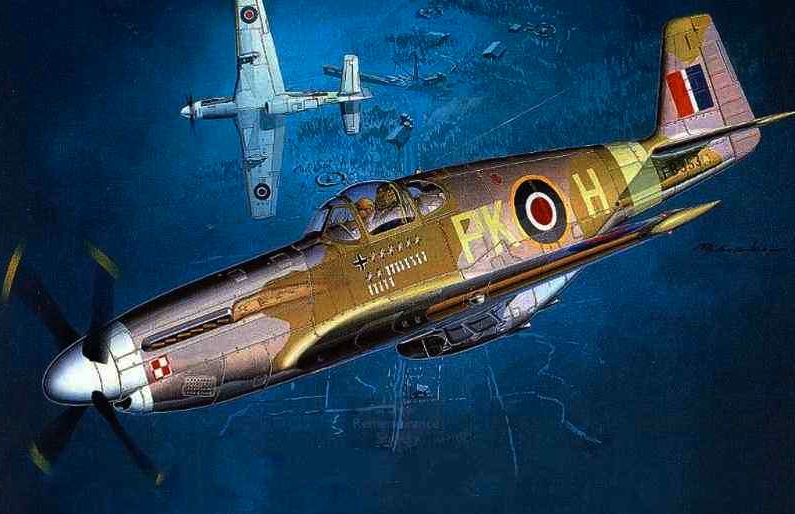
Then he was posted into 315 Squadron at Heston onto Spitfires. He, Mike Gorzula and Kaz Kijak were now flying together although they were not in the same social group. Kaz was married and would go to see his wife and son at every opportunity while Kuba was popular with the ladies.
At 315, Kuba flew the MkVb Spitfire on eight missions before the squadron changed over to Mustang IIIs. On his first mission the engine began to run rough at altitude and, very disappointed and worried about being thought a coward, he turned back. At lower altitudes the engine came back on song but he returned anyway. It turned out to be another case of a defective supercharger and the aircraft was sent back for repairs.
In late March 1944 315 Squadron flew to Llanbedr in Wales for gunnery practice. It was here that Kuba’s skill behind the trigger became apparent.
Just prior to D-Day, whilst over France at 32,000 feet, on a fighter sweep, enemy aircraft were spotted below. Kuba dropped into a very steep power dive. He remembers that eh aircraft quickly became uncontrollable and with a loud crack, the canopy blew off! Kuba immediately backed off the throttle and eventually regained control. By this time he was down at 17,000 feet and had recognised the enemy aircraft as Spitfires. With no combat to engage in, the Mustangs levelled off and set course for home.
On the 7th of June, after a dive bombing mission, Kuba and his comrades climbed for height. Kuba was a little higher and behind his comrades and on emerging into a clear space between cloud layers, Kuba found himself in the midst of a formation of Me109s. He was above and behind the leader, gaining on him. Kuba immediately cut power in an effort to get in behind him and at that moment the German saw him and winged over to port, to escape. At the same time, the German number 3 also winged over, but to starboard. In an ugly scene, the two collided and fell to earth. Kuba jerked his stick back and rammed the throttle forwards to avoid them and climbed into clear air at 17,000ft. Disoriented and rather shaken by what he had seen and his narrow escape, he slowly spiralled up to 18,000 whilst calling Fighter Control for a course to steer home. Then, routinely looking in the rear view mirror, he was shocked to find the rest of the German staffel filling it, preparing to fire. He automatically, pushed over into a steep dive and then added a little sideslip. A second later tracer and cannon rounds streamed past to starboard. Further side slipping at judicious moments foiled two other attacks and eventually the Germans gave up. Kuba’s claim for two was denied by the squadron’s Intelligence Officer as they had not been shot down, a decision which caused some ill feeling in the squadron.

Top left: Film Bojowy(Combat) No. 2599 2 T.A.F. Fl/Sgt. Bargielowski 315 Dyon (Squadron) 12-06-1944 Atakowanie (Attacking) Fw. 190.
Right: Film Bojowy (Combat) No. 7775 ADGB. Fl/Sgt. Bargielowski 315 Dyon (Squadron) 18-07-1944 Mustang. Atakowanie Latajagej Bomby (Attacking flying bomb - V1)
On the 12th of June, Kuba was part of a section of four aircraft flying to dive-bomb a target in France. Over Seese, the squadron leader called that he had spotted several FW190s below. Every one dropped their bombs and dove down to attack. Kuba noticed that his port wing was heavy and found that the bomb had not dropped from its rack. Following procedure, he briefly fired his guns to jar it loose. The firing had dropped him slightly behind the others and he found himself in behind him at full throttle and closing to firing range. The German spotted him and peeled away to port. Kuba was too close and too fast to stay with him and the German whipped around and was on his tail. Kuba thought he was in real trouble. Pulling with all his strength, the stick in his lap and banking vertically, Kuba knew he could not out-turn the Fw190 on his tail. With nothing for it, he pulled ten degrees of flap and he found himself again on the tail of the German. He opened fire and shot him down.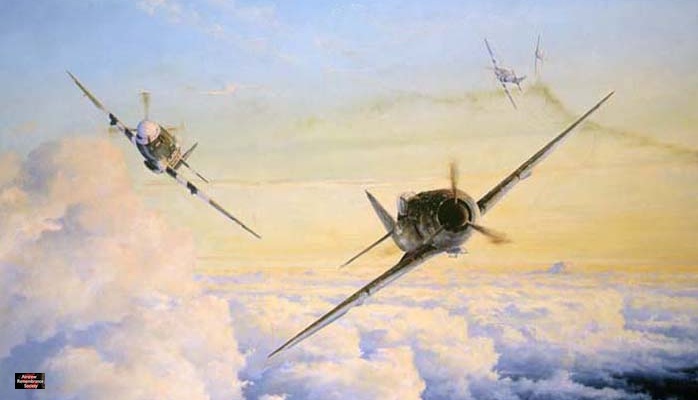 315 Squadron attacking Fw190.
315 Squadron attacking Fw190.
A few moments later he saw a Mustang chasing an Fw190. They were vertical and Kuba sense the German was going to loop or maybe do an Immelmann turn. As the German’s belly came uppermost, Kuba pounced on him from in front and began firing. The German was good. He was upside down, in a loop and a number of his bullets went through the arc of Kuba’s propeller. Kuba dived under him at a distance of four or five metres and could see the German was on fire. He vanished into the trees below and died.
At about the same time that Rommel was straffed and injured, Kuba attacked a limousine and escort in the same area. He was convinced that it was he that had shot Rommel up.
During July and August 315 did many anti-Diver patrols against the V1 flying-bombs being sent over from France. Kuba watched and analysed the attacks he witnessed and decided that he would only attack from behind. He got three chances to do this and knocked each one down.
Kuba flew in the Battle of Beauvais on the 18th of August. In a whirl of banking and firing, Kuba claimed nine and one possible. A couple of weeks later the area was liberated. The number of wrecks discovered tallies with the total kills claimed, including Kuba’s nine.
The next few months were mainly spent doing long-range daylight bomber escort missions. He flew escort on the aircraft carrying paratroopers to Operation Market Garden at Arnhem and Nijmegen in Holland. On his last patrol over the area, there was an unidentified yellow Spitfire flying, criss-crossing the area.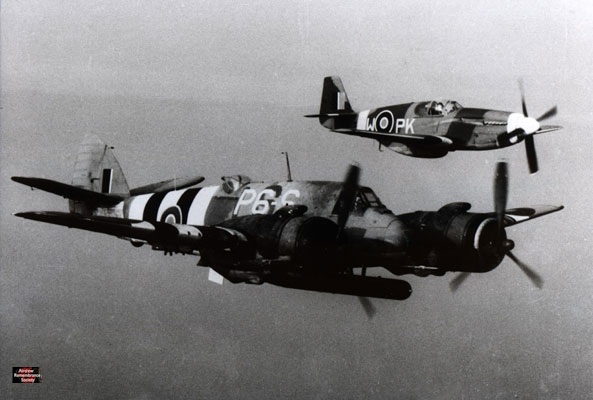 315 Squadron escorting Beaufighters (A.R.Society archive)
315 Squadron escorting Beaufighters (A.R.Society archive)
On the 1st of November 1944, 315 Squadron was posted to Peterhead in Scotland where they flew escort for Beaufighters and Mosquitoes doing anti-shipping strikes along the coast of Norway. These flights lasted between five and six hours. The flights to Norway, via Sumburgh Island were at fifty feet to keep under the German radar. Flying that low was stressful. On the 7th of December on a mission to Gossen Island, Kuba’s section (he was number 2) were flying through broken cloud when an Me 109 infiltrated the formation and shot down the section leader. Kuba witnessed this and diving hard, angrily chased the attacker. Firing short bursts that did not seem to have any effect, they neared the sea. The Me109 made to pull up hard and Kuba anticipating this, pulled up a little earlier. The 109 came squarely into his sights and he hit it with a good burst. The Me109 disintegrated and fell into the sea. Meanwhile Kuba was himself pulling very hard on the stick to avoid bellying into the water. He blacked out for a moment and came to he was climbing steeply going through 4,000 feet. He eased back to level, went back to coarse pitch and throttled back, could see no-one, and the radio was out so turned south-west and settled back for the long trip home. In that action, 315 Squadron, even though the squadron wasn’t there in full strength, shot down six Me109s and two probables.
On the 28th of December, saw another mission to Norway. Cloud cover was total and in layers. The Mosquitoes dropped through a hole in the clouds down to sea level. Kuba was the last of the escort and he delayed before dropping through. Just then many Me109s materialised out of the cloud with Kuba amongst them. He radioed the situation and lined up on the one in front of him. Before he could fire, the engine of the Me109 exploded and the aircraft fell into the sea.
On the 3rd of April 1945, Kuba was awarded the Distinguished Flying Medal and then taken off operations. He appreciated that as his nerves were getting rather strained.
Kuba was credited with five and a half kills and three V1s.
At the end of the war, until disbandment of the Polish Air Force in 1946, he served in 303 Squadron.
Because of unfriendly conditions in Poland he could not return to the land he loved and missed for his whole life.
In 1948 he emigrated to Australia. On arrival he worked on the New South Wales Railways, at one point working as an engine cleaner, then as a technician in the Post Master General’s Department.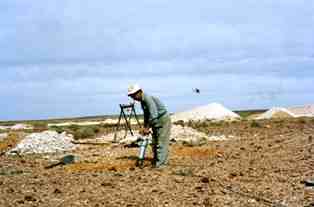 Kuba mining for Opals
Kuba mining for Opals
After a year he bought a truck with a friend and moved to Coober Pedy in South Australia and began mining and polishing opal. He would spend the cooler months in the opal fields and then take his raw opals back to his house in Sydney where he would cut and polish them. After some time, Kuba moved his digging to the town of White Cliffs in far northern New South Wales. He also bought raw opal from other miners, returning home as the weather warmed up to cut polish and sell. He sold the opals all over the world.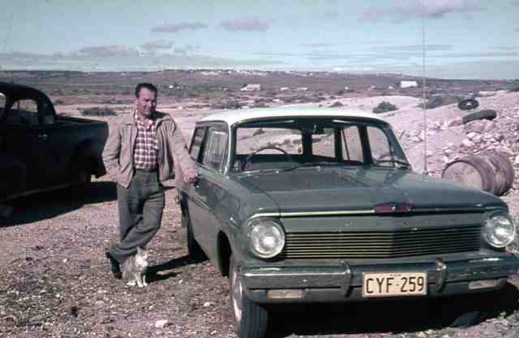 Kuba at White Cliffs
Kuba at White Cliffs
In 1960 for the first time since the end of the war, he visited Poland. Kuba officially retired in 1964 but every season until the early 1990s would travel to White Cliffs.
He married briefly in the late 1950s but divorced soon after. He has no children.
Kuba was very proud of his military service. He instituted ANZAC Day services at White Cliff in the early 1960s and arranged for a cairn to be built, commemorating servicemen and women.
Since about 2005, Kuba has been affected by the onset of dementia. We have recently been informed (April 2010) that Kuba passed away in Sydney, Australia.
Article researched and written for the Aircrew Remembrance Society by Alan Scheckenbach of Canberra, Australia.

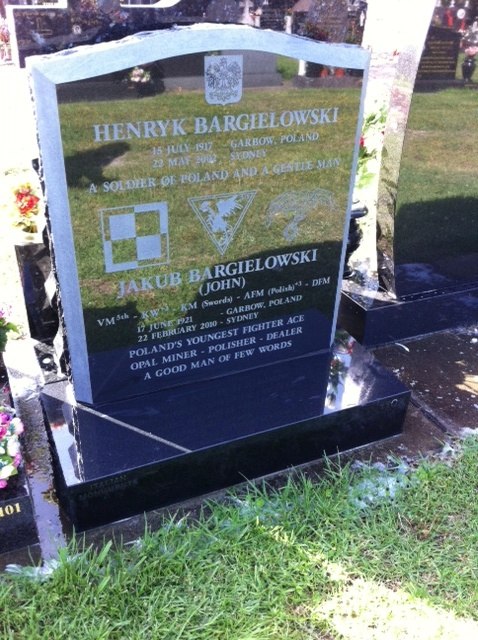 His grave, cleaned and polished in November 2011 by Alan Scheckenbach
His grave, cleaned and polished in November 2011 by Alan Scheckenbach
